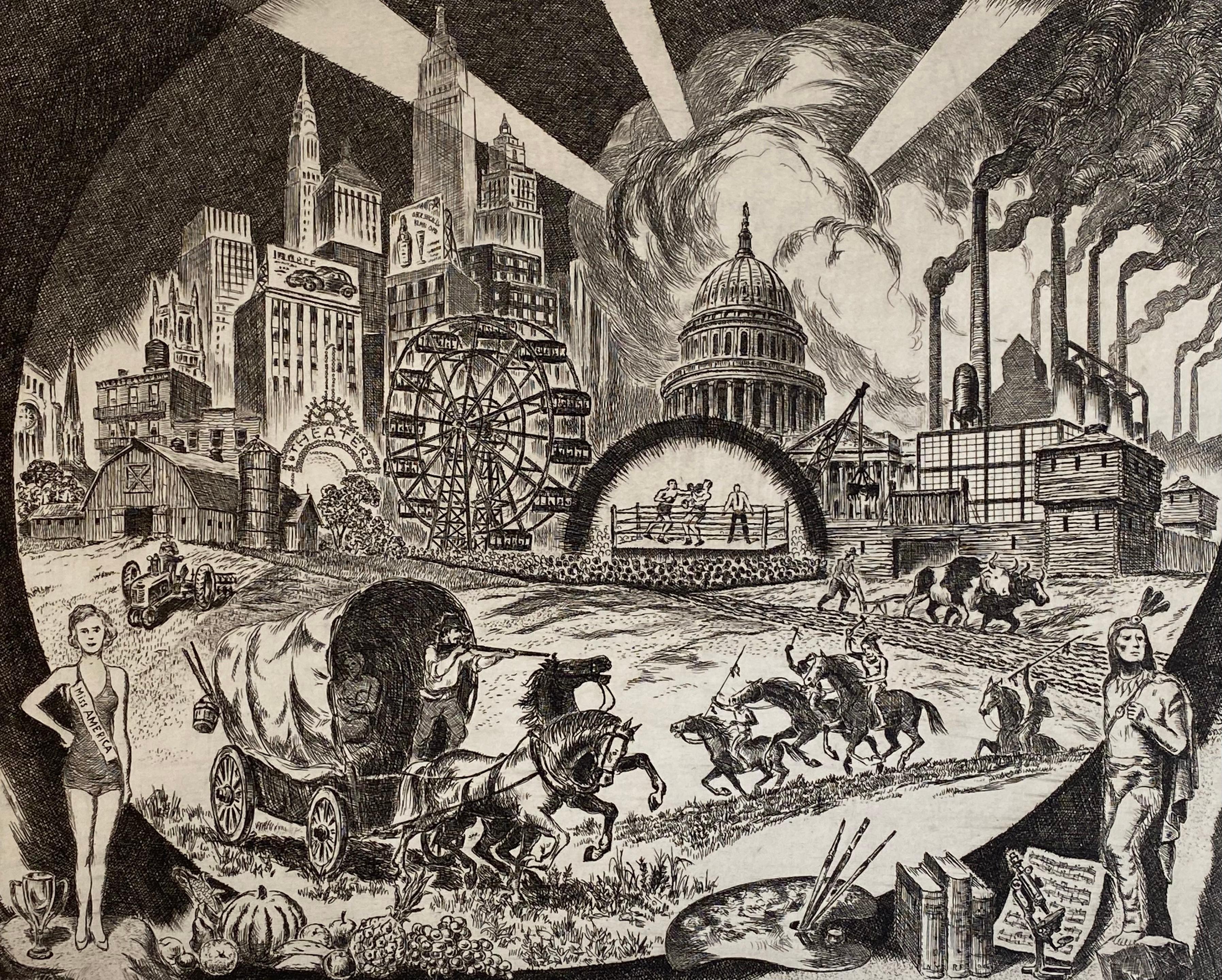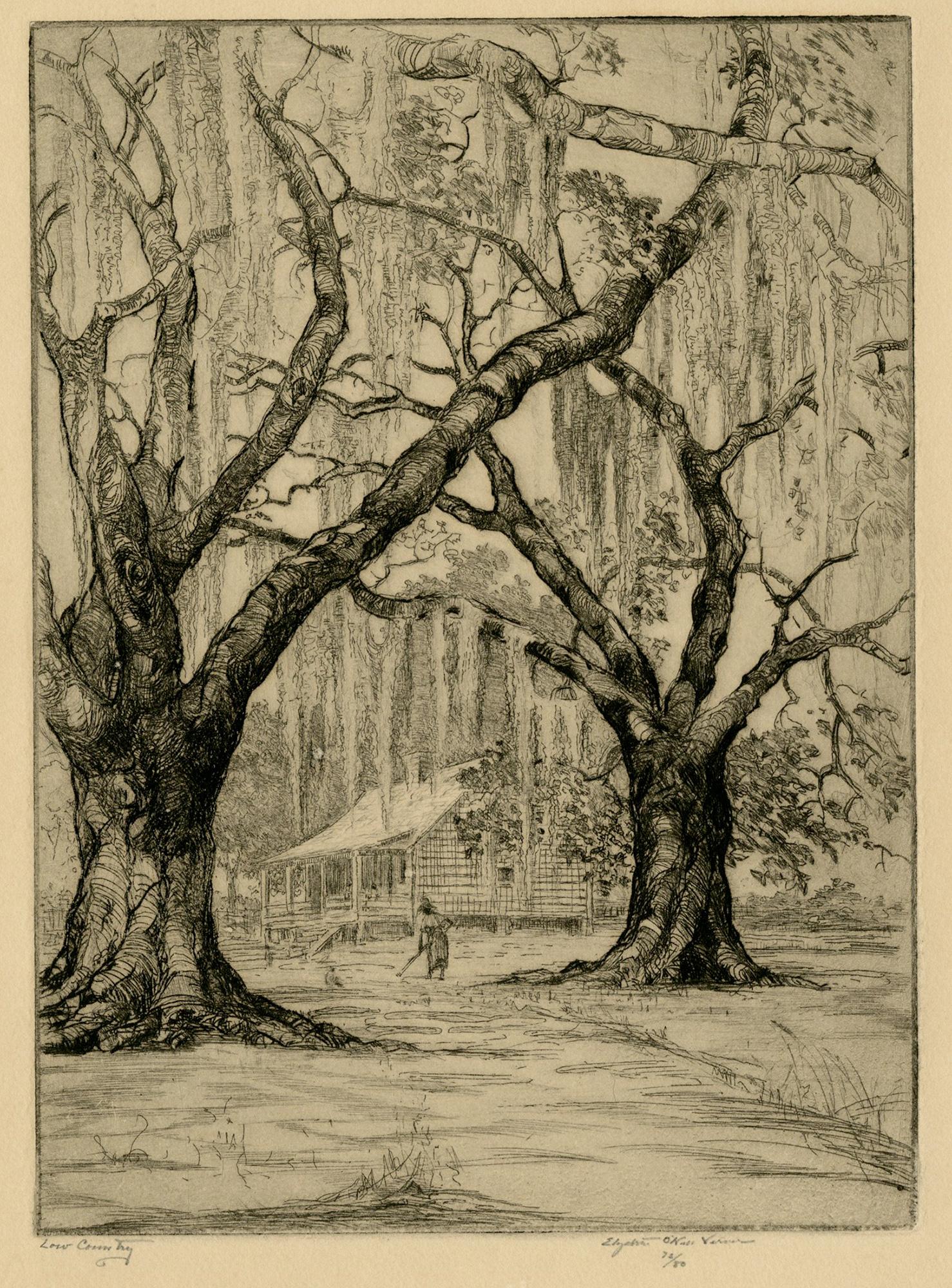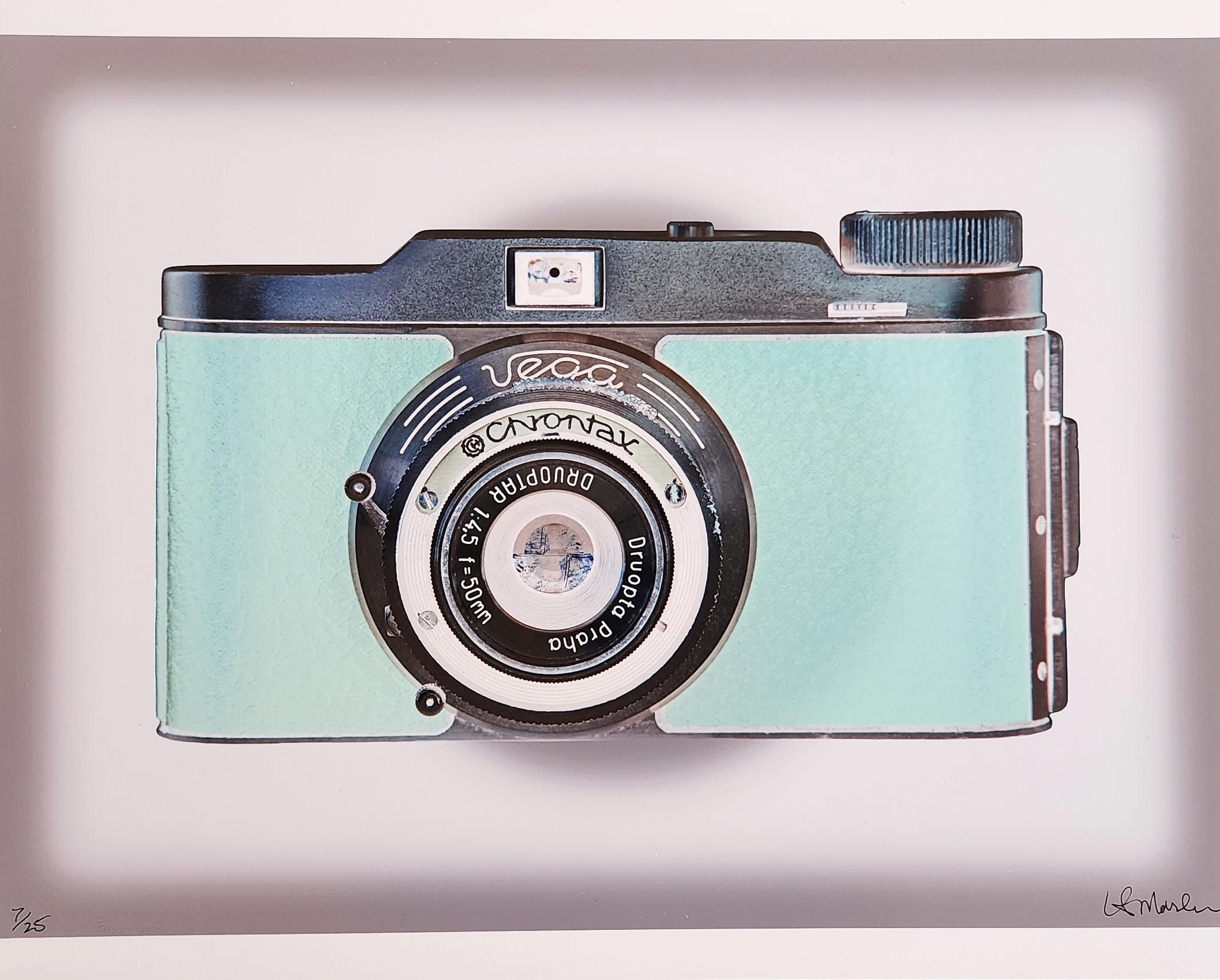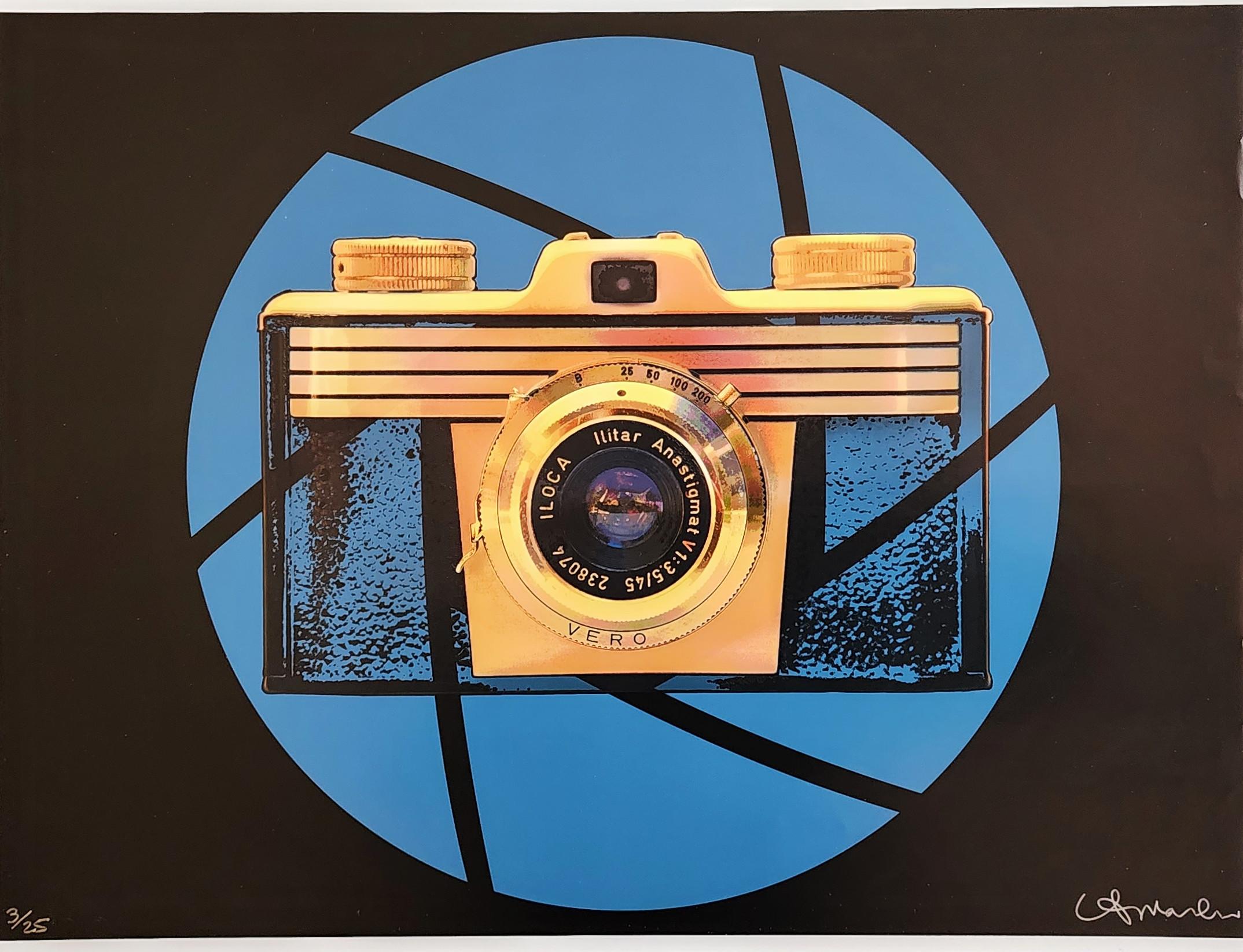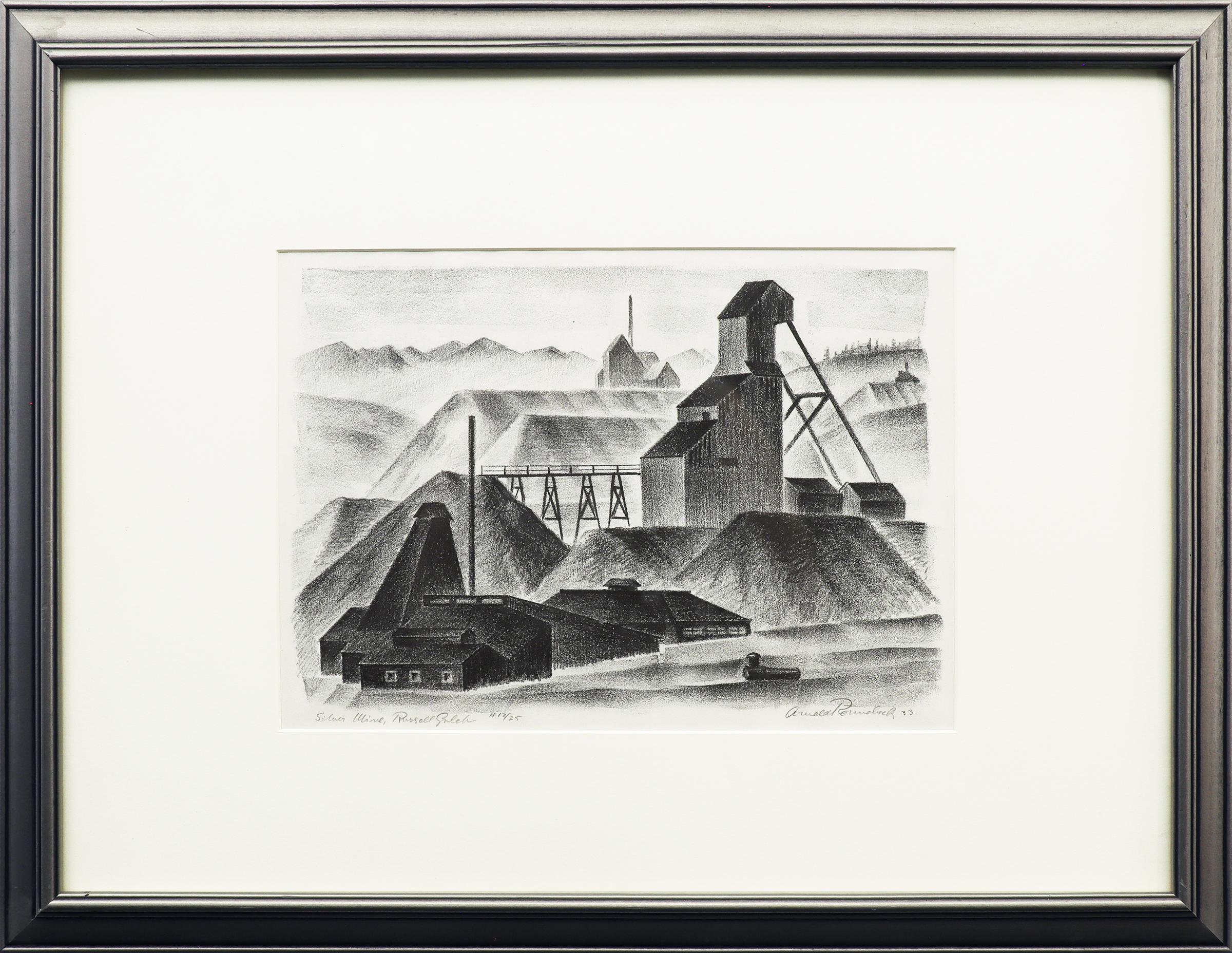Items Similar to "Blues" 1971 African American Artist - Color lithograph Framed
Video Loading
Want more images or videos?
Request additional images or videos from the seller
1 of 11
Charles White"Blues" 1971 African American Artist - Color lithograph Framed 1971
1971
About the Item
A wonderful print by African American artist, Charles White (1918 - 1979)
"Blues"
Color lithograph on Rives paper, 1971.
11.5 x 26.75 inches (28.55 x 68.7 cm)
Signed, titled, dated and numbered in pencil, lower right.
Number 63/100 from the numbered edition of 100.
Framed
Printed by William Law III and the Tamstone Group, Los Angeles, with their blindstamps lower right.
Charles Wilbert White was an artist of his people. He always insisted upon the dignity of the individual and respect for the human being. As a spiritual product of his race and environment, he reflected the fact that his grandfather was a slave in Mississippi and his mother had lived most of her life in the South, where little had changed from her father's day.
His respect for men, women and children was apparent in this search for the meaning of truth in terms of the daily life and the beauty that can be found through his drawings, paintings and prints. A warm understanding of the meaning of existence, man's aspirations and sorrows, his inner spirit, but above all his dignity, form the central core of Charles White's love affair with life. He is quoted as saying, "Paint is the only weapon that I have that which to fight what I resent. If I could write, I would write about it. If I could talk, I would talk about it. Since I paint, I must paint about it."
Charles White was born in 1918 in Chicago, where the family had migrated from the South. His parents were Ethel Gary and Charles White Sr., a Creek Indian. He lived and worked in his studio in Altadena, CA. for his last 20 years, until he died in Los Angeles in 1979.
His youth was spent in Chicago. His mother, a domestic worker, took young Charles to work with her. One day to keep him out of mischief she bought him a set of oil paints, which he then proceeded to use on the window shades. His earliest painting dates to when he was only seven years old.
His solace in a difficult life was the drawing board, and he continued to paint and draw as much as possible. He entered a nationwide high-school contest and won first prize. Later he applied for a scholarship at the Art Institute of Chicago and was granted scholarship for full-time study.
After his studies, Charles White was able to work professionally with other artists with the WPA. In 1939 under the auspices of the W.P.A. he painted the mural, "Five Great American Negroes" for the Cleveland Branch of the Chicago Public Library. This same years he exhibited at Howard University and received a commission from the Associate Negro Press to do the mural, "History of the Press" for the American Negro Exposition, Chicago.
Now the artist was able to speak about the Negro heroes of American history and their contribution to American life. As a W.P.A.painter, Charles White would show Booker T. Washington, educator; Frederick Douglass, statesman; George Washington Carver, scientist; and Marian Anderson, singer, on the same mural.
His works of art are found in museums throughout the United States, Germany, Africa and Japan. A partial list includes: Museum of Modern Art; Whitney Museum of American Art; Los Angeles County Museum of Art; Howard University Museum; Atlanta University Museum; Oakland Museum; Tuskegee Institute.; American Federation of the Arts; Academy of Arts and Letters; Hirshhorn Museum, Taller de Grafica, Mexico City; Deutsche Academy der Künste, Berlin; Dresden Museum of Art.
Sources:
Benjamin Horowitz, "Images of Dignity, Drawings of Charles White", 1967; Sherman, Charlotte Sherman, "Charles White, Images of Dignity", exhibition catalogue, Bakersfield Museum of Art, February 26, 2004 - May 3, 2004.
September 2003
- Creator:Charles White (1918 - 1979, American)
- Creation Year:1971
- Dimensions:Height: 11.5 in (29.21 cm)Width: 26.75 in (67.95 cm)
- Medium:
- Movement & Style:
- Period:
- Condition:In very fine, age appropriate condition.
- Gallery Location:Rancho Santa Fe, CA
- Reference Number:1stDibs: LU516314317252
About the Seller
5.0
Vetted Seller
These experienced sellers undergo a comprehensive evaluation by our team of in-house experts.
Established in 1984
1stDibs seller since 2016
79 sales on 1stDibs
Typical response time: 2 hours
- ShippingRetrieving quote...Ships From: New York City, NY
- Return PolicyThis item cannot be returned.
More From This SellerView All
- “Le Nu” The Nude - Color lithograph 1978 - Framed - Signed - angel, birdBy Marc ChagallLocated in Rancho Santa Fe, CAMarc Chagall "Le Nu" Lithograph in colors on Arches paper 21.25 x 14 in. (image size) 25.5 x 18.38 in (sheet size) Edition of 50 + Épreuve d'artiste Signed in pencil lower rig...Category
1970s Modern Figurative Prints
MaterialsArchival Paper, Lithograph
- "Paris de ma fenêtre" 1969-1970 Paris from My Window - Color lithographBy Marc ChagallLocated in Rancho Santa Fe, CAMarc Chagall "Paris de ma fenêtre" 1969-1970 Lithograph in colors on Arches paper 32.5 x 23.75 inches (image size) 39.5 x 27.5 inches (sheet size) Edition of 50 + 25 AP Signe...Category
1960s Modern Figurative Prints
MaterialsArchival Paper, Lithograph
- Saint Mathew, from the Twelve Apostles suite (signed & numbered limited edition)By Salvador DalíLocated in Rancho Santa Fe, CALithograph on Arches paper with embossing and gold foil by the Spanish surrealist artist Salvador Dali. From the 1977 Twelve Apostles Suite (sometimes ...Category
1970s Surrealist Figurative Prints
MaterialsGold Leaf
- Saint Andrew from The Twelve Apostles suite (signed & numbered limited edition)By Salvador DalíLocated in Rancho Santa Fe, CALithograph on Arches paper with embossing and gold foil by the Spanish surrealist artist Salvador Dali. From the 1977 Twelve Apostles Suite (sometimes referred to as the Knights of the Roundtable Suite). Signed and numbered in pencil. This image is sometimes referred to as "Visions of Camelot." Edition Size: 350. Paper Size: 22.5 x 18.8 in. Referenced in; The Official Catalog of the Graphic works of Salvador Dali" by Albert Field as 72-14 C. Published by S. Wajntraub, P. Moore, A. Lancel and J. Carpentier, Paris. Framed Provenance: Martin Lawrence Gallery...Category
1970s Surrealist Figurative Prints
MaterialsGold Leaf
- Seven Sculpture Ideas I - ETCHING, AQUATINT and ROULETTE in TEN COLORSBy Henry MooreLocated in Rancho Santa Fe, CASeven Sculpture Ideas I (Cramer 589) Etching, aquatint and roulette in 10 colors, 1982, on Arches, signed in pencil. 39/50 From the numbered edition of 50. Published by The Raymond ...Category
1980s Surrealist Abstract Prints
MaterialsArchival Paper, Etching, Aquatint
- Untitled (Head of a Woman)By Hughie Lee-SmithLocated in Rancho Santa Fe, CAInscribed, signed, and dated lower center: "Monoprint H Lee-Smith '69" Provenance: The Waintrob Project for the Visual Arts (Foundation); Sidney and Abraham Waintrob This item is i...Category
1960s Post-War Figurative Prints
MaterialsMonotype, Paper
You May Also Like
- Fruit Tree (Japanese-American, Sculptor, Print Maker, Cultural Identity, Iconic)By Akio TakamoriLocated in Kansas City, MOAkio Takamori Fruit Tree, 1993 Medium: 4 Color Lithograph Edition: 30 Paper: Rives BFK, White Paper Size: 33.5″ x 15″ Image Size: 29.5″ x 11″ Signed, dated, numbered and inscribed by...Category
1990s American Modern Figurative Prints
MaterialsLithograph, Archival Paper
- “Americana”By Ralph FabriLocated in Southampton, NYHere for your consideration is a wonderful original etching on archival paper by the well known American artist, Ralph Fabri. Strong impression; signed in pencil by the artist lower right margin. Titled and dated bottom left of the sheet “1947-Americana”. Condition of the etching is excellent. Top corner of sheet and bottom right corner of sheet have tiny creases. Not visible, under the mat. Sheet size is 12 by 15 inches. Image size is 8 by 9.75 inches. Matted but not framed. Provenance: A Long Island, New York collector. Painter and printmaker, commercial artist, writer, and teacher, Ralph Fabri was born Fabri Reszo in Hungary in 1894. He was educated in Budapest, first studying architecture at the Royal Institute of Technology from 1912 to 1914. He then enrolled in the Royal Academy of Fine Arts, from which he graduated in 1918 with a Professor's Diploma (M.A.) "for teaching drawing, painting and geometry – including descriptive and projective geometry – in schools of higher education." Fabri arrived in New York City in 1921 and soon adopted the anglicized version of his name, Ralph Fabri. He began doing commercial design work and during the academic year of 1923/24 was enrolled as an evening student at the National Academy of Design. After becoming an American citizen in 1927, he traveled extensively in Europe. Upon returning to New York that same year, Fabri decided his financial situation was stable enough to allow him to focus his attention on fine art. During the Great Depression, Fabri's already inadequate portrait commissions and art sales further declined and he returned to commercial work. He established a workshop known as the Ralph Fabri Studios, that designed theatrical and movie sets, window displays, and retail interiors. But Fabri found the workshop dirty and distasteful, and eventually was able to concentrate on advertising work which could be done from home. The largest clients for his pen and ink drawings were The Stamp and Album Co. of America, Inc. (for which he designed covers for stamp albums and produced illustrations for envelopes housing sets of stamps sold to collectors), Geographica Map Co., and Joseph H. Cohen & Sons (for whom he designed and illustrated mail order catalogs). Another source of income during this period was the design and construction of an addition to "Iroki," Theodore Dreiser...Category
1940s American Modern Figurative Prints
MaterialsArchival Paper, Etching
- Low Country (South Carolina)By Elizabeth VernerLocated in Middletown, NYAn enchanting Southern landscape by the mother of the Charleston Renaissance. A native of Charleston, South Carolina, and educated under the tutelage of Thomas Anshutz at The Pennsylvania Academy of Fine Arts, O'Neill Verner was a teacher, a mother, an artist, an ardent preservationist, and a skilled autodidact. Having previously focused on painting, in the early 1920s she found herself deeply moved by printmaking as a media, and especially so by the simple, peaceful themes and tableaus she discovered in Japanese art. She embarked on a effort to teach herself Japanese printmaking techniques, and in the process, produced the charming images of every day life in Charleston and its environs that earned her recognition as a cultural icon in her day, and in more modern times, as the mother of the Charleston Renaissance, which flourished well into the 1930s. In 1923 she opened a studio in Charleston where she focused on documenting the local color and the architecture and landscape that distinguishes Charleston as one of the South's most beautiful cities, all the while applying the gentle and poetic thematic sensibilities of Japanese printmaking. O'Neill Verner soon found herself in high demand when municipalities and institutions throughout the country sought commissions from her to document the beauty of their grounds and historic buildings. She worked as far north as the campuses of Harvard and Princeton, and extensively across the South, including in Savannah, Georgia, where through sweeping commissions she was able to marry her love of southern preservation and art. O'Neill Verner was a lifelong learner, and continued a path of edification that led her to study etching at the Central School of Art in London, to travel extensively through Europe, and to visit Japan in 1937, where she studied sumi (brush and ink) painting. She was a founding member of the Charleston Etchers Club, and the Southern States Art League. Her works are represented in the permanent collections of leading museums across the American south, and in major national institutions including the Metropolitan Museum of Art, Boston's Museum of Fine Art, and the Smithsonian American Art Museum. O'Neil Verner...Category
Early 20th Century American Modern Landscape Prints
MaterialsArchival Paper, Drypoint, Etching
- Vega ChrontaxLocated in Kansas City, MOLouise Marler Vega Chrontax Archival Pigment Print on premium luster 2022 Size: 16x20in Edition: 25 Signed and numbered by hand Stamped COA provided Ref.: 924802-1416 Louise Marler’s photo-based Mixed Media art, is iconic visual vocabulary. Au-thentic style has led to exhibits, art collections and events which integrate his-tory, education, and entertainment. Raised in a family that collected, sold and repaired typewriters. These and other analog, vintage machines are part of her personal history and led naturally to becoming part of the subject matter of her visual expression. Louise Marleris inspired by Americana and also influenced by pop art and technology. “I developed my unique art style in a Santa Monica Airport (former mechanic) hanger turned art studio. I currently live and work in St. Louis where antique row meets the most progressive art culture, as well as Joshua Tree, California, where I created the first Type Inn.” Louise Marler’s work is featured in the documentary film, “The Typewriter in the 21st Century,” and TV shows including “Two and a Half Men,” “Curb Your Enthusiasm,” “The Mentalist,” “Criminal Minds,” “Jane the Virgin,” “Dear White People,” “Lucifer,” “Arrested Development,” “Love Victor, and “A Black Lady Sketch.” film photography, film camera, film is not dead, film community, old camera...Category
2010s American Modern Figurative Prints
MaterialsArchival Paper, Archival Pigment, Archival Ink
- KoniRapid-SLocated in Kansas City, MOLouise Marler KoniRapid-S Archival Pigment Print on premium luster 2022 Size: 16x20in Edition: 25 Signed and numbered by hand Stamped COA provided Ref.: 924802-1417 Louise Marler’s photo-based Mixed Media art, is iconic visual vocabulary. Au-thentic style has led to exhibits, art collections and events which integrate his-tory, education, and entertainment. Raised in a family that collected, sold and repaired typewriters. These and other analog, vintage machines are part of her personal history and led naturally to becoming part of the subject matter of her visual expression. Louise Marleris inspired by Americana and also influenced by pop art and technology. “I developed my unique art style in a Santa Monica Airport (former mechanic) hanger turned art studio. I currently live and work in St. Louis where antique row meets the most progressive art culture, as well as Joshua Tree, California, where I created the first Type Inn.” Louise Marler’s work is featured in the documentary film, “The Typewriter in the 21st Century,” and TV shows including “Two and a Half Men,” “Curb Your Enthusiasm,” “The Mentalist,” “Criminal Minds,” “Jane the Virgin,” “Dear White People,” “Lucifer,” “Arrested Development,” “Love Victor, and “A Black Lady Sketch.” film photography, film camera, film is not dead, film community, old camera...Category
2010s American Modern Figurative Prints
MaterialsArchival Ink, Archival Paper, Archival Pigment
- Silver Mine, Russell Gulch (12/25) Abstract Black and White Print in MountainsBy Arnold RönnebeckLocated in Denver, COLithograph on paper titled 'Silver Mine, Russell Gulch (12/25)' by Arnold Ronnebeck, which is a black and white lithograph print of an oil painting by him of the same name. It shows a mine with a mountain ridge in the background. Presented in a custom frame measuring 20 ½ x 26 ½ inches. Image size measures 10 ¼ x 14 ¼ inches. Print is clean and in very good vintage condition - please contact us for a detailed condition report. Provenance: Estate of Arnold Ronnebeck Expedited and international shipping is available - please contact us for a quote. About the Artist: Modernist sculptor, lithographer and museum administrator, Rönnebeck was a noted member of European and American avant-garde circles in the early twentieth century before settling in Denver, Colorado, in 1926. After studying architecture at the Royal Art School in Berlin for two years beginning in 1905, he moved to Paris in 1908 to study sculpture with Aristide Maillol and Émile-Antoine Bourdelle. While there he met and befriended American modernist painter, Marsden Hartley, of whom he sculpted a bronze head that was exhibited at the Salon d’Automne in Paris in 1912 and the following year at Hartley’s solo show of paintings at Alfred Stieglitz’s Gallery 291 in New York. A frequent guest of Gertrude Stein’s Saturday "evenings" in Paris, she described Rönnebeck as "charming and always invited to dinner," along with Pablo Picasso, Mabel Dodge (Luhan) and Charles Demuth. After the outbreak of World War I in 1914, Rönnebeck returned to Germany where he served as an officer in the German Imperial Army on the front lines. Twice wounded, including in the Battle of Marne in France, Kaiser Wilhelm II awarded him the Iron Cross. During the war Hartley fell in love with Rönnebeck’s cousin, Lieutenant Karl von Freyburg, who was killed in combat. As a tribute to Freyburg, Hartley created Portrait of a German Officer (1914) now in the Metropolitan Museum of Art in New York. After the war Rönnebeck traveled in Italy with German writer, Max Sidow, and German poet, Theodor Daubler, doing a series of drawings of Positano and the Amalfi Coast that formed the basis for his lithographs on the subject. The death of his finacée, the young American opera singer Alice Miriam in 1922 and his own family’s increasing financial problems in post-World War I Germany led him to immigrate to the United States in 1923. After living briefly with Miriam’s family in Washington, DC, he moved to New York where he became part of the avant-garde circle around Alfred Stieglitz. His essay, "Through the Eyes of a European Sculptor," appeared in the catalog for the Anderson Gallery exhibition, "Alfred Stieglitz Presents Seven Americans: 159 Paintings, Photographs & Things, Recent & Never Publicly Shown, by Arthur G. Dove, Marsden Hartley, John Marin, Charles Demuth, Paul Strand, Georgia O’Keeffe, Alfred Stieglitz." In New York Rönnebeck began producing Precisionist-style lithographs of the city’s urban landscapes which he termed "living cubism." Some of them were reproduced in Vanity Fair magazine. Through Stieglitz he met Erhard Weyhe head of the Weyhe Gallery who, with its director Carl Zigrosser, arranged Rönnebeck’s first solo American exhibition in May 1925 at the gallery in New York. Comprising some sixty works – prints, drawings and sculpture – the show subsequently traveled on a thirteen-month tour of major American cities. Until the end of his life, the gallery represented him, along with other American artists Adolf Dehn, Wanda Gag, Rockwell Kent, J.J. Lankes, Louis Lozowick, Reginald Marsh and John Sloan. In the summer of 1925, as the guest of Mabel Dodge Luhan, Rönnebeck first saw Taos, New Mexico, which Marsden Hartley had encouraged him to visit. It was there that he met his future wife, Louise Emerson, an easel painter and muralist. A year later they were married in New York before relocating to Denver. He served as director of the Denver Art Museum from 1926 to 1930 where he invited Marsden Hartley to lecture on Cézanne’s art in 1928. Rönnebeck fostered the development of the museum’s collection of American Indian art and the curation of modernist art exhibitions. In addition to his work at the museum, he was professor of sculpture at the University of Denver’s College of Fine and Applied Arts from 1929 to 1935, and wrote a weekly art column in the Rocky Mountain News. His best known Denver sculptures from the late 1920s in bronze, copper, stone, wood and terra cotta include a reredos, The Epiphany, at St. Martin’s Chapel; The History of Money (six panels) at the Denver National Bank; The Ascension at the Church of Ascension; and the William V. Hodges Family Memorial at Fairmount Cemetery. At the same time he did a series of terra cotta relief panels for La Fonda Hotel in Santa Fe, New Mexico. In the 1930s his bas-relief aluminum friezes of stylized Pueblo and Hopi Indian Kachina masks...Category
1930s American Modern Figurative Prints
MaterialsPaper, Lithograph
Recently Viewed
View AllMore Ways To Browse
Old Vintage Library
Window Shades
Scientist Vintage
Vintage Weapon
African American Mother
Berlin Men
Old Vintage Window Frames
American Carver
Vintage Slave
Library Book Sets
Law Library
Charlotte P
Charles Howard Artist
Framed Wpa Prints
Anderson Lithograph
Vintage Window Shades
Wpa Pencil Drawing
Vintage Indian Window
